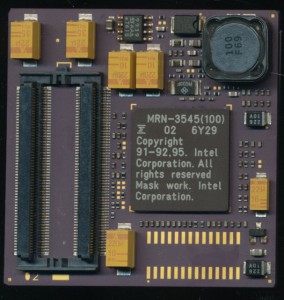An Interesting Fujitsu MCM Pentium Module
We have seen Fujitsu MCM Pentiums before. 120MHz, 133MHz 150MHz and MMX ones. One is pictured in the article on the MicroModule Systems Gemini here. The 100MHz module is similar, though it is missing the L2 cache tag RAM (256 kbit chip on the top of the package) as well as the 2 cache RAM chips normally installed on the backside of the module. It would appear that Fujitsu offered these modules with the cache being optional. There was a 133MHz version (MRN-3548) with cache, and one (MRN-3549) without cache.
These processors were typically used in environmentally challenging environments. Panasonic famously used them in their ToughBook CF25, the beginning of a line of highly durable laptop in 1996. Some of these applications were sealed environments, they did not have vents, or active cooling. This obviously makes cooling a challenge. Removing the L2 cache, while causing a significant hit in performance, would alleviate some of the heat generation.
We consider L2 cache to be essential, but many applications do not require it. Intel infamously removed the L2 Cache completely from the first Celeron processors and while they worked, they were not particularly competitive performance wise. When competing against wind, rain dirt, and droppage? L2 cache may not be so important
Posted in:
CPU of the Day



